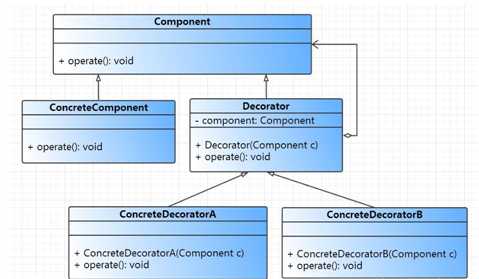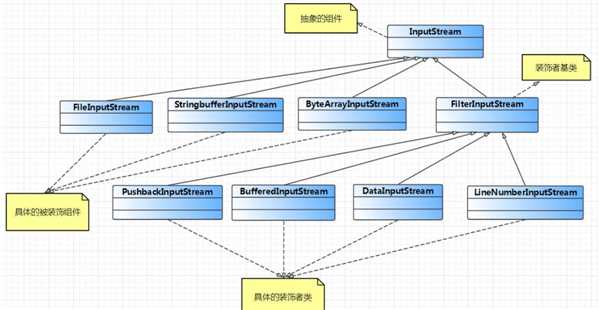标签:size stream his end 需要 buffer 添加 一个 原则
一.定义
装饰者模式(Decorator Pattern):动态的给一个对象添加新的功能,同时又不改变其结构。又叫装饰器模式
若要扩展功能,装饰者模式提供了比继承更有弹性的替代方案
二.装饰者模式的角色
抽象构件(Component)角色:是一个抽象类或者接口,是要装饰原始对象
具体构件(ConcreteComponent)角色:要装饰的实际对象
装饰(Decorator)角色:是一个抽象类,继承和实现Component接口,同时拥有一个对Component实例对象的引用,也可以有自己的方法
具体装饰(ConcreteDecorator)角色:具体的装饰者,负责给ConcreteComponent动态的增加新功能。
UML图

三.示例
1 /** 2 * 抽象构件角色: 要装饰的原始角色 3 */ 4 public abstract class Component { 5 public abstract void operate(); 6 } 7 8 /** 9 * 需要被装饰对象的实现类 10 */ 11 public class ConcreteComponent extends Component { 12 @Override 13 public void operate() { 14 System.out.println("ConcreteComponent 实际要被装饰的对象"); 15 } 16 } 17 18 /** 19 * 1.抽象的装饰器类继承或者实现抽象组件类 20 * 2.拥有一个对组件类的引用 21 */ 22 public abstract class Decorator extends Component { 23 private Component component; 24 25 public Decorator(Component component) { 26 this.component = component; 27 } 28 29 @Override 30 public void operate() { 31 // 调用装饰者方法 32 component.operate(); 33 } 34 } 35 /** 36 * 实际装饰者A 37 * 38 */ 39 public class ConcreteDecoratorA extends Decorator { 40 41 public ConcreteDecoratorA(Component component) { 42 super(component); 43 } 44 45 @Override 46 public void operate() { 47 super.operate(); 48 operateAMethod(); 49 } 50 51 public void operateAMethod(){ 52 System.out.println("ConcreteDecoratorA 自己的方法"); 53 } 54 } 55 56 /** 57 * 实际装饰者B 58 */ 59 public class ConcreteDecoratorB extends Decorator { 60 public ConcreteDecoratorB(Component component) { 61 super(component); 62 } 63 64 @Override 65 public void operate() { 66 super.operate(); 67 operateBMethod(); 68 } 69 70 public void operateBMethod(){ 71 System.out.println("ConcreteDecoratorB 自己的方法"); 72 } 73 }
测试结果:
1 Component component = new ConcreteComponent(); 2 Component componentA = new ConcreteDecoratorA(component); 3 Component componentB = new ConcreteDecoratorB(component); 4 componentA.operate(); 5 componentB.operate();

透明的装饰者和半透明的装饰者
透明的装饰者:要求具体的构建角色、装饰者接口与抽象构建角色的接口一致,这种在使用的时候两种类型没有区别,都是继承或者实现了抽象构建角色, 方法的接口也是完全相同的,可以通过抽象类型的引用去操作,对外是透明的,这种是理想的模式
半透明的装饰者: 如果装饰角色的接口与抽象构建角色的接口不一致,也就是说装饰角色的接口宽一些,装饰角色实际上已经成了一个适配器,这种属于半透明的装饰者模式,这种模式下子类可以有自己的个性化方法。
四.装饰者模式在实际中的应用
1.jdk中的应用
输入流 输出流 字符流 都涉及装饰者模式,每个嵌套层都有自己的特性
1 OutputStream outputStream = new BufferedOutputStream(new FileOutputStream(new File("user.txt"))); 2 InputStream inputStream = new DataInputStream(new BufferedInputStream(new FileInputStream(new File("reader.txt"))));


五.适用场景及优缺点
使用场景:
扩展一个类的功能或者给一个类添加附加职责
优点:
继承的有力补充,比继承灵活,在不改变原有对象的基础上给一个对象扩展新的功能
通过使用不同的装饰类或者这些装饰类的排列组合,可以实现不同效果
符合开闭原则
缺点:
会出现很多装饰类,增加代码复杂性
状态装饰时,多层装饰时会更复杂
标签:size stream his end 需要 buffer 添加 一个 原则
原文地址:https://www.cnblogs.com/kukufan/p/12748587.html